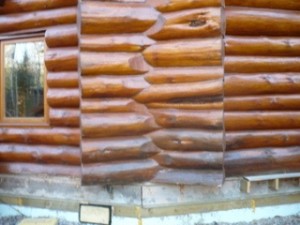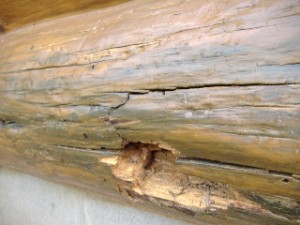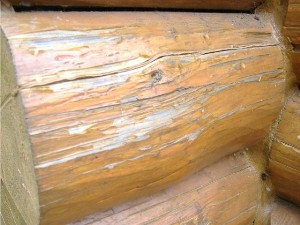Repair and restoration of log homes – In our 40 years in the log home restoration and repair business, we have seen many disastrous problems with rot in log homes. Some of the most tragic problems we have seen have been the result of having what I refer to as a “film-forming finish” on the logs.
When I say tragic I mean we have seen extensive rot in homes that are 10 years old or less. While the rotted logs cannot be blamed solely on these “film-forming finishes”, it is certainly a factor that adds significantly to their decay.
Let me take a minute to explain what I mean by “film-forming finishes” and what we expect from finishes in general and then get into how they can cause problems on log homes and cabins.
It is a widely accepted rule in the log home industry that we expect finishes on log homes to breathe. Logs naturally have a large ability to soak up moisture and so any finish that is applied to them needs to be breathable to allow the logs to dry out when they get wet. Film forming finishes are defined by the fact that they sit on the surface of the log and after the initial application don’t generally soak into the wood at all. Instead, they form a film on the surface of the logs.


When the wood gets wet (and stays wet), it causes problems. The problem with these film-forming finishes is that they do not allow the wood to breathe enough and this in turn can lead to some serious rot problems. Film-forming finishes in- clude the Sikkens Cetol system and at least one of the Behr“premium” stains.
We have found that most times the problem begins after the second application of this type of “stain”. It may be that the buildup does not become problematic until that second coat is applied. Blackening of the areas in question is the first sign that there is a problem with moisture. Once the blackening starts (see photo), it is often too late.
I have seen logs that are so wet behind the finish that I could press on them with my thumb and water oozed out of the wood through nearby cracks.
I am not suggesting that a house with “film-forming finish” is invariably going to rot. Here is the deal: The film formed by these types of finish keeps the moisture content high by causing it to retain moisture in the wood. When logs retain a lot of moisture and are not allowed to dry out… that’s when we see the rot begin. Using a film-forming finish on wood that is getting wet is like adding gas to a fire.


Rot happens in this situation in relatively little time. We have inspected homes that are less than ten years old and they have hundreds of feet of rotten logs. What makes this particularly “tragic” is that many times, the worst problems arise because the homeowners are trying do the “right thing” by applying the finish as suggested by the manufacturer. The irony is that these folks have put more of this finish on in an effort to properly maintain their log home and the buildup gets worse with each application.
To add to this irony — many builders’ warranties run out after five to ten years. In my opinion, in many of these cases, the rot began in the first year or two but the obvious rot doesn’t show up until five or ten years down the road — right about when the warranty expires. The homeowner has no option but to pay for the expensive repairs.
In conclusion, it is my professional opinion that there is no place for this type of finish in the maintenance of log homes. We see too many log homes with these finishes on them and the problems are consistent. Stay away from “film-forming finishes”.
Here are some links to our site that have lots more information for you to check out:
Why Do Logs Rot?
Frequently Asked Questions (FAQ)
Replacing logs
Contact us or call our toll-free number 715-373-5744